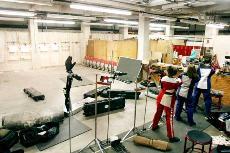
Along the corridor of Reynolds Coliseum’s west side is a small white door marked only with the word “STAIRS.” Down those stairs is the 58-year-old building’s basement, which is sectioned off in chain-linked sections.
It’s hot and humid and poorly lit.
Noise echoes off the uncovered concrete walls, while construction and maintenance crews bustle around renovation sites throughout the basement.
And tucked away in the northwest corner of the basement is a cage designated for N.C. State’s rifle team.
Looking more like a carpenter’s shop than a shooting range, the Wolfpack does its best with the facilities it’s given. Senior Matthew Gifford said the team’s facilities are hardly enough for what it needs.
“Being the rifle team, we’re last on the budget — which maybe we should be because we don’t bring in money like football,” he said. “But our facility is barely adequate. We have to go other places to get what we need.”
In fact, of the team’s two events — air rifle and smallbore — it can only practice one on campus. The players have to travel 25 minutes to the Wake County Public Firearms Education and Training Center in Apex, N.C., to practice with the smallbore rifles.
Coach Keith Miller said his facilities — or lack thereof — are an obstacle in recruiting. Instead, he often relies on N.C. State to sell itself.
“I like kids who already have interest in N.C. State,” he said. “It’s tough to find a school that has good academics and a pretty good rifle program, so overall, it’s a pretty easy sell.
“Quite frankly, the biggest negative is the facilities because we don’t have our own smallbore facility. And that’s what I’ve got to sell them on, we don’t have the facilities, but we do the best with what we’ve got.”
Miller said he does have scholarship money to award his players and to use on the recruiting trail.
“NCAA-wise, 3.6 is the most scholarships you can award [among a rifle team],” Miller said. “Technically, we have 3.6 scholarships, but those are limited to in-state scholarship numbers.”
In other words, the Athletics Department limits the rifle team’s scholarships to in-state tuition, room and board. Miller said in-state tuition is roughly $12,500, while out-of-state scholarships are close to $24,000.
But the coach, who is now in his 17th year, isn’t bitter.
“It’s better than where we were five years ago,” he said. “There were no scholarships. There was no pay for the coaches. I volunteered for this job for 12 years. So, we are better than where we were.”
For Miller, rifle is different from other sports because it’s “the only pure coed sport there is.”
“In fact, if you look at the big picture and forget about N.C. State for a minute, rifle is the only pure coed sport there is,” he said. “If you look at all the NCAA champions, half of them are women. And I really like that aspect.”
And with that said, Miller said universities often look at rifle as a way to make sure they comply with Title IX. Nebraska, Mississippi and Texas Christian are three universities Miller said have all female rifle teams. And with Nebraska earning top-5 rankings the past few years, top universities have demonstrated an all-female team can beat a coed or all-male team.
State, however, is admittedly a ways away from being like Nebraska. For now, Miller said the team is trying to garner interest and more support from the University.
The team’s next home meet is Jan. 27, when it hosts the Southeastern Air Rifle Conference’s No. 5 event in Raleigh.